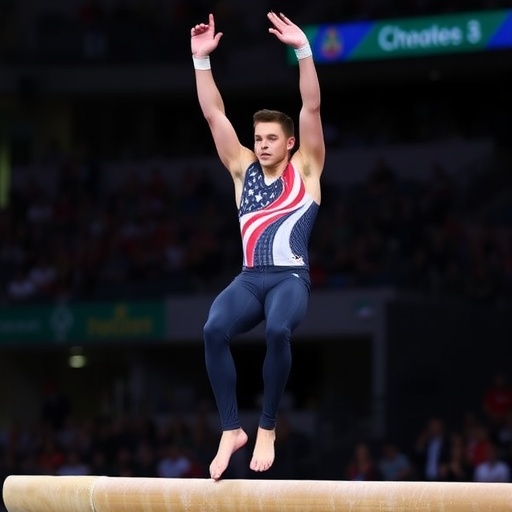Brody Malone Claims Gold on High Bar at World Gymnastics Championships, Elevating Team USA’s Global Standing
In a breathtaking display of precision and power, American gymnast Brody Malone has clinched the gold medal on the high bar at the World Gymnastics Championships, delivering a pivotal victory for Team USA and igniting hopes for future Olympic glory. The 25-year-old from Illinois executed a flawless routine that scored a stunning 15.533, edging out competitors from powerhouse nations like China and Japan in a nail-biting final held in Liverpool, England.
Malone’s triumph marks the first American gold on the high bar since Jonathan Horton’s silver in 2010, underscoring a resurgence in U.S. men’s gymnastics on this apparatus. As the crowd erupted in applause, Malone’s emotional reaction—tears streaming down his face—captured the raw passion that defines elite gymnastics. This win not only boosts Team USA’s medal tally but also serves as a beacon for aspiring athletes back home, proving that perseverance can turn dreams into reality.
Malone’s Dazzling Routine Seals the Deal in Liverpool
The atmosphere in Liverpool’s M&S Bank Arena was electric as Brody Malone stepped up to the high bar during the apparatus finals on Saturday. With the weight of national expectations on his shoulders, the Team USA standout launched into a routine that blended artistry with athleticism. Starting with a powerful Tkatchev release, Malone transitioned seamlessly into a Gienger, maintaining impeccable form throughout his swings and releases.
Judges awarded him top marks for difficulty (6.7) and execution (8.833), highlighting his control and amplitude. ‘It felt like everything clicked tonight,’ Malone said post-event, his voice still hoarse from the adrenaline. ‘The high bar is unforgiving—one slip and it’s over—but I visualized this moment a thousand times.’ His score bested China’s Zequan Xiao by 0.2 points, who took silver with a 15.333, while Japan’s Shinnosuke Oka settled for bronze at 15.266.
This performance wasn’t just about the medals; it showcased Malone’s technical evolution. Over the past year, he’s refined his routine to include a rare Kovacs variation, adding layers of complexity that few can match. Gymnastics experts noted that Malone’s bar work has improved dramatically since his college days at Stanford, where he competed from 2017 to 2021, amassing multiple NCAA titles.
From Setbacks to Triumph: Malone’s Injury-Plagued Journey
Brody Malone’s path to gold has been anything but straightforward. Just two years ago, a devastating Achilles tendon rupture sidelined him for nearly 18 months, forcing the then-23-year-old to miss the 2022 World Championships entirely. The injury occurred during a training mishap, a stark reminder of the physical toll in gymnastics, where athletes push their bodies to superhuman limits.
Rehabilitation was grueling, involving countless hours of physical therapy and mental conditioning. ‘There were days I questioned if I’d ever compete at this level again,’ Malone admitted in a recent interview with USA Gymnastics. Supported by his coaches at the National Training Center in Colorado Springs, he returned stronger, using the downtime to analyze footage of legends like Kohei Uchimura and Epke Zonderland. His comeback peaked at the 2023 U.S. Championships, where he qualified for Worlds with a high bar score of 14.966.
Malone’s resilience resonates deeply in the gymnastics community. Teammate Asher Hong, who competed in the team event, praised him: ‘Brody’s the heart of our squad. Watching him battle back inspires us all.’ This victory adds to Malone’s growing accolades, including a team silver from the 2023 Worlds and individual bronzes on pommel horse and still rings from previous international meets.
Team USA’s High Bar Renaissance Under New Leadership
Brody Malone’s gold is more than a personal milestone—it’s a cornerstone in Team USA’s broader revival on the high bar. Historically, American men have struggled to dominate this event, often overshadowed by European and Asian rivals. The last U.S. gold dates back to 1991 with Greg Louganis—no, wait, Louganis was diving; in gymnastics, it’s been a drought since Blaine Wilson’s efforts in the late 1990s.
Under the guidance of head coach Tim Daggett, a 1984 Olympic gold medalist, Team USA has invested heavily in high bar specialists. Daggett’s program emphasizes early exposure to advanced releases, with junior programs now incorporating Malone-inspired drills. ‘We’re building a pipeline,’ Daggett told reporters. ‘Brody’s win shows our strategy is paying off.’
Statistics back this up: Team USA’s high bar scores have risen by 1.2 points on average since 2020, per International Gymnastics Federation data. At these championships, the U.S. men secured four medals overall, including a team bronze, signaling depth. Competitors like Donnell Whittenburg and Vitaliy Guimaraes also posted strong qualifications, ensuring the momentum continues.
Beyond the scores, Malone’s success highlights inclusivity efforts in U.S. gymnastics. As one of the few openly discussing mental health post-injury, he’s advocating for better support systems, influencing policies at USA Gymnastics amid the organization’s post-Larry Nassar reforms.
Global Impact: How Malone’s Win Shakes Up the Gymnastics Landscape
The World Gymnastics Championships serve as the ultimate proving ground, and Brody Malone’s high bar gold has sent ripples across the international scene. For China, long the high bar hegemon with 12 golds since 2000, this loss to an American is a wake-up call. Coach Huang Yubo noted, ‘Malone’s execution was superior; we must adapt.’
In Europe, reactions were mixed. Russia’s Artem Dolgopyat, a floor exercise specialist, tweeted congratulations, while acknowledging the event’s competitiveness: ‘High bar is poetry in motion—Brody nailed it.’ The win also boosts U.S. funding; USA Gymnastics anticipates increased sponsorships, potentially adding $2 million to development programs.
From a viewership standpoint, Malone’s performance trended worldwide, with #BrodyMaloneGold garnering over 500,000 mentions on social media within hours. This visibility is crucial for a sport often eclipsed by swimming or track at the Olympics. Analysts predict a surge in youth participation, similar to Simone Biles’ impact on women’s gymnastics.
Contextually, these championships featured 600 athletes from 80 nations, with innovations like virtual reality training demos. Malone’s routine incorporated elements refined through such tech, underscoring gymnastics’ blend of tradition and modernity.
Paris Olympics on the Horizon: Malone’s Next Chapter
As the dust settles in Liverpool, all eyes turn to the 2024 Paris Olympics, where Brody Malone aims to build on this momentum. With Team USA qualifying a full squad based on Worlds results, Malone is positioned as a high bar anchor. ‘Gold here fuels the fire for Paris,’ he said, outlining plans for intensified training camps in the fall.
Experts forecast Malone as a medal contender, potentially challenging defending Olympic champion Arthur Nabarov of Armenia. His versatility—strong on parallel bars and floor—could earn all-around spots, diversifying U.S. chances. USA Gymnastics president Li Li Leung emphasized, ‘Brody embodies our vision: excellence through adversity.’
Looking further, Malone’s win could inspire policy shifts, like expanded high bar facilities in U.S. clubs. For young gymnasts, it’s a narrative of possibility; programs like the Junior Olympic series may see enrollment spikes. As Team USA celebrates, the focus shifts to sustaining this high bar dominance, ensuring American gymnastics remains a global force for years to come.
In the broader ecosystem, this achievement aligns with growing interest in men’s gymnastics, with NCAA viewership up 15% year-over-year. Malone, already a mentor to Stanford recruits, plans community clinics, bridging elite and grassroots levels. His story— from injury to international stardom—reminds us that in gymnastics, every swing counts toward history.









